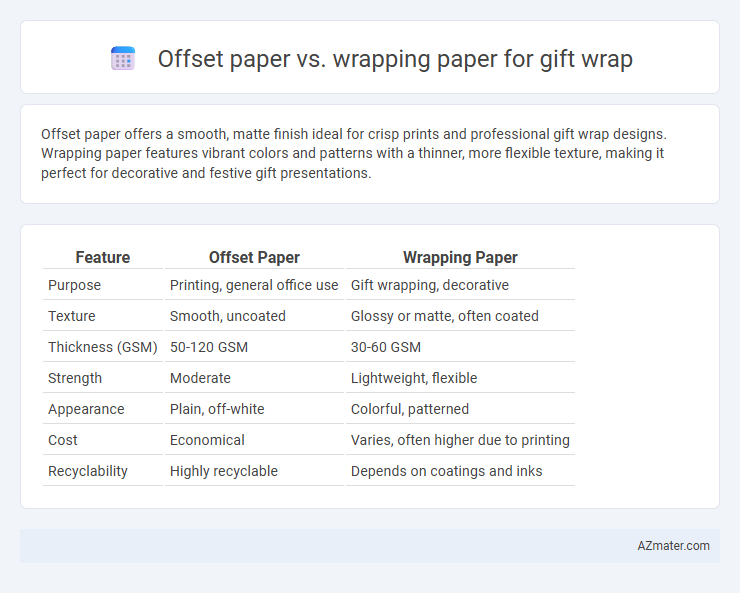Offset paper offers a smooth, matte finish ideal for crisp prints and professional gift wrap designs. Wrapping paper features vibrant colors and patterns with a thinner, more flexible texture, making it perfect for decorative and festive gift presentations.
Table of Comparison
| Feature | Offset Paper | Wrapping Paper |
|---|---|---|
| Purpose | Printing, general office use | Gift wrapping, decorative |
| Texture | Smooth, uncoated | Glossy or matte, often coated |
| Thickness (GSM) | 50-120 GSM | 30-60 GSM |
| Strength | Moderate | Lightweight, flexible |
| Appearance | Plain, off-white | Colorful, patterned |
| Cost | Economical | Varies, often higher due to printing |
| Recyclability | Highly recyclable | Depends on coatings and inks |
Introduction to Offset Paper and Wrapping Paper
Offset paper, characterized by its smooth texture and high-quality finish, is primarily designed for printing purposes and offers excellent ink absorption for crisp, clear images. Wrapping paper, on the other hand, is specifically manufactured for decorative gift wrapping, featuring vibrant colors, patterns, and varying thicknesses suited for aesthetic appeal and durability during handling. Choosing between offset and wrapping paper depends on the desired visual effect and functionality in gift presentation.
Material Composition: Offset vs Wrapping Paper
Offset paper is primarily made from high-quality wood pulp with a smooth, uncoated surface designed for printing clarity and durability, making it ideal for detailed graphics and text. Wrapping paper typically consists of thinner, more flexible materials such as coated or laminated paper blends that allow for vibrant colors and easy folding around gifts. The difference in material composition affects texture, print quality, and structural integrity, with offset paper offering sturdiness and wrapping paper emphasizing decorative appeal.
Surface Texture and Print Quality
Offset paper features a smooth, matte surface ideal for high-quality, detailed printing with sharp text and vibrant colors due to its uniform texture. Wrapping paper typically has a glossy or semi-gloss finish, enhancing color brightness but often sacrificing fine detail clarity because of its coated surface. The choice between offset and wrapping paper depends on the desired print sharpness and tactile feel, with offset paper excelling in precision and wrapping paper offering eye-catching shine.
Strength and Durability Comparison
Offset paper offers higher strength and durability compared to wrapping paper, making it ideal for securely protecting gifts during transit. Its dense fiber composition provides resistance to tearing and wrinkles, ensuring the gift remains intact and presentable. Wrapping paper, typically thinner and more decorative, is more prone to damage and less suitable for heavy or bulky items.
Flexibility and Ease of Wrapping
Offset paper offers moderate flexibility and a smooth surface, making it suitable for crisp folds but sometimes challenging for intricate shapes due to its stiffness. Wrapping paper provides higher flexibility and a thinner texture, allowing for easier manipulation around complex contours and delicate presents. The choice depends on whether precise creases or adaptable coverage is prioritized in gift wrapping.
Cost Considerations for Gift Wrapping
Offset paper offers a cost-effective solution for gift wrapping due to its lower production expenses and bulk availability, making it ideal for large volume uses. Wrapping paper, often featuring decorative prints and higher-quality finishes, tends to be pricier but provides enhanced aesthetic appeal and texture. Choosing between offset paper and wrapping paper depends on balancing budget constraints against the desired visual impact for gifts.
Design and Aesthetic Versatility
Offset paper offers a smooth, matte finish that enhances printed designs with crisp, vibrant colors, making it ideal for detailed and sophisticated gift wrap patterns. Wrapping paper typically features a glossy or textured surface that allows for a wide range of decorative styles, including metallic prints, embossing, and varied color palettes, adding tactile and visual interest. The design versatility of offset paper suits minimalist and elegant themes, while wrapping paper excels in festive, playful, or thematic aesthetics, catering to diverse gift-giving occasions.
Environmental Impact and Recyclability
Offset paper, commonly used for high-quality printing, is typically made from wood pulp and may contain coatings or chemical additives that can hinder recyclability and increase environmental impact. Wrapping paper, especially those made from recycled or biodegradable materials, generally has fewer chemical additives, making it easier to recycle and more eco-friendly when sourced sustainably. Choosing uncoated, recyclable wrapping paper reduces landfill waste and supports sustainable forestry practices compared to the more resource-intensive production of offset paper.
Common Uses in Gift Wrapping
Offset paper is commonly used for elegant gift wrapping due to its smooth texture and ability to hold sharp folds, making it ideal for crisp, polished gift presentations. Wrapping paper is designed specifically for gift wrapping, featuring decorative patterns and a coated surface that resists tearing, perfect for quickly wrapping varied shapes and sizes. While offset paper excels in formal or corporate gift packaging, wrapping paper is preferred for festive, casual, or themed gift occasions.
Choosing the Right Paper for Your Gift
Offset paper offers a smooth, matte finish ideal for printing intricate designs and logos, making it perfect for personalized gift wraps requiring precise color reproduction. Wrapping paper is usually coated and designed with festive patterns, providing durability and vibrant aesthetics to enhance the presentation of any gift. Choosing the right paper depends on whether you prioritize print quality with offset paper or decorative appeal with traditional wrapping paper.

Infographic: Offset paper vs Wrapping paper for Gift wrap
 azmater.com
azmater.com